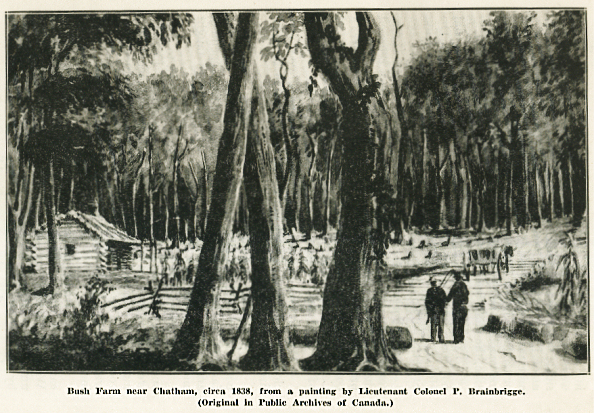A synopsis of a paper by
T. K. HOLMES, M.D.
DR. HOLMES states that in the year
1800 there were in what is now the County of Kent, probably not more than
twenty families. Dr. Holmes’ paternal grandfather settled on Lot 23,
Concession 1, Harwich, in 1796, and his father was born there in 1797,
being the first white child born in Kent. His father lived on that farm
until 1870, and then moved to Chatham where he died in 1890. Dr. Holmes
gathered his data from his father regarding early days in Kent County, and
says:
"At the dawn of the nineteenth
century this County was an unbroken wilderness over which roamed a few
bands of Indians who pursued their game through the trackless forest, or
fished in its sluggish streams. Deer, bears, wolves, wild turkeys and
foxes were plentiful, while smaller game was abundant then and for many
years after.
Until 1845 the land in Kent was
heavily timbered with oak, walnut, whitewood, beech, maple, ash and elm,
and about that time a demand for some of these, especially for walnut,
whitewood, and oak sprang up. The walnut and whitewood were exported for
building and furniture and the oak was manufactured into staves and
shipped to the West Indies for casks, and used there for sugar, molasses
and rum. A few years later beech and maple were cut into cordwood and
exported for fuel, or used on locomotives on the Great Western Railway.
The demand for forest products gave an impetus to business among the
farming community and greatly accelerated the clearing of the land. A
standard saw log of walnut containing 303 feet of board measure sold for
fifty cents in 1846."

Dr. Holmes states that the swampy
land retarded the progress of the County and as late as 1860 the crops
were inferior on this account. Malaria and ague had a debilitating
influence on the settlers. Up to the farm work was mostly done by oxen.
Grain was first reaped with the sickle, later by the cradle and finally in
1847 the first reaper made its appearance owned by John Williams who lived
a mile east of Kent Bridge. Grain was threshed by hand flail or trodden
out by horses on the barn floor, the first threshing machine being owned
by William Partridge of Walkerville, the chaff being separated by a
separate fanning mill.
Tallow candles provided
illumination. Kerosene did not come into general use until about 1860. In
1867 Dr. Holmes carried a lantern on dark nights even though King Street,
Chatham, was lighted by a few oil lamps.
Neighborly visits, dancing, music,
mostly on the violin, some athletic games, and logging and husking bees
relieved the monotony of rural life. Books were few but highly prized,
such as Pilgrim’s Progress, a history of Pizarro’s Conquest of Peru, a
life of Napoleon, and the novels of Captain Marryat and Jane Austin, and
Pope’s translation of the Iliad and Odyssey.
For clothing the women spun the yarn
and wove it into cloth on hand looms, and the homes were heated by open
fireplaces.
Up to 1845 school teachers were
often unqualified, poorly paid and usually boarded in succession with the
families in the school section. Reading, writing, spelling, arithmetic and
geography were the only branches taught and few schools were open all
year.
The practice of medicine and surgery
was open to anyone with a smattering knowledge of drugs. The "Doctor" went
his rounds on horseback and usually augmented his income by cultivating
some land or pursuing some other vocation. The University of Toronto
School of Medicine was opened in 1827, but for many years the teaching was
inefficient.
Lack of transportation and
transmission of news in the early days was a drawback . news of the Battle
of Waterloo, fought on June 18, did not reach Kent until late in
September. Mail was transported on foot and by lumbering coaches drawn by
four horses; these coaches were the only means of public conveyance.
Before grist mills were built along
the Thames and along Lake Erie, the inhabitants had to take their grain by
canoe to Sandwich, where it was ground by windmill.
Dr. Holmes gives a description of
Tecumseh as related to him by his father, who as a lad of sixteen was
present at Arnold’s Mill, on a small creek leading into the Thames, where
Tecumseh and his braves encamped the night before the battle of the
Thames. Tecumseh is described as being about feet 10 inches in height,
erect, and of fine bearing. His dress consisted of buckskin leggings and
moccasins and an upper garment of the same material reaching to his knees
and fastened by a sash at the waist. His head dress was adorned with
plumes and his manner indicated alertness and activity. When departing
Tecumseh remained standing near the mill holding his horse by the head
until the last of his braves had gone some distance on their eastward
march. He then mounted and rode after them. He had remained behind to
prevent the mill from being burned, knowing how essential the mill was to
the settlers.

